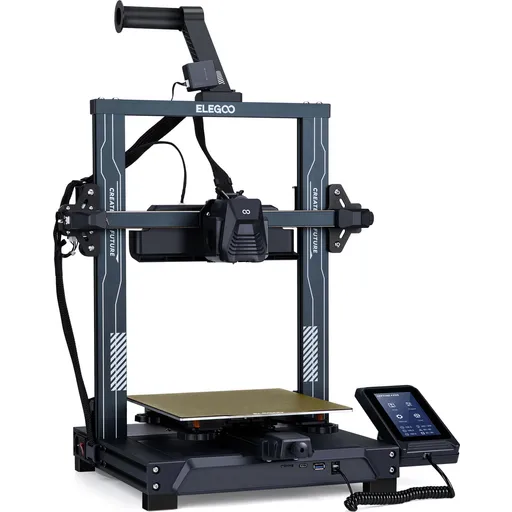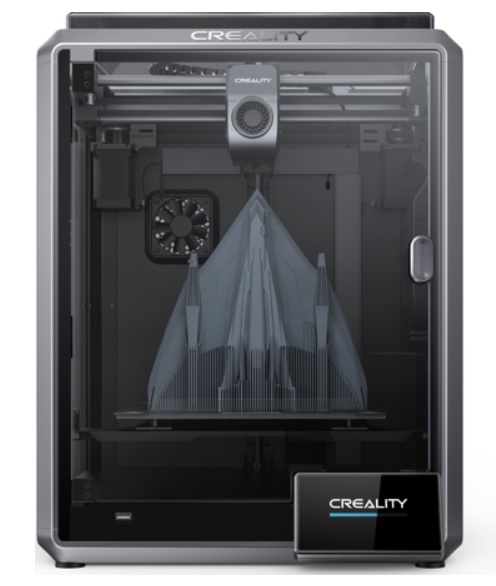Compare Neptune 4 PRO vs K1
Comparison between the best 3D printers
Choose the best 3D printer at the best price. The cheapest 3D printers are here.
Buy a 3D printer here with 3D Fila.
 |
 |
|
| Model | Neptune 4 PRO |
K1[BUY K1] |
| Printing Material | Filament | Filament |
| Buy Filament for Elegoo Neptune 4 PRO | Buy Filament forCreality 3D K1 | |
| Estimated price | $359,00 | $399,00 |
| Manufacturer | Elegoo | Creality 3D |
| Release Year | 2023 | 2023 |
| Print Volume [mm] | 225x225x265 | 220x220x250 |
| Printer Size [mm] | 475x445x515 | 355x355x480 |
| Weight [kg] | 8,9 | 12,5 |
| Power Loss Recovery | YES | YES |
| Enclosed printer | NO | YES |
| Bed Leveling | Automatic | Automatic |
| Filament End Sensor | YES | YES |
| Bed type | Heated | Heated |
| Power supply system | Direct Drive | Direct Drive |
| Standard nozzle | 0,4 | 0,4 |
| Maximum Nozzle Temperature [°C] | 300 | 300 |
| Maximum Bed Temperature [°C] | 110 | 120 |
| Maximum printing speed [mm/s] | 500 | 600 |
| Filament holder | YES | YES |
| Camera for supervision | NO | NO |
| Recommended filaments | PLA, PLA+, TPU, PETG, Nylon, ABS | ABS, PLA, PETG, PET, TPU, PA, ABS, ASA, PC, PLA-CF, PA-CF, PET-CF |
| Recommended slicers | Bambu Studio, Super Slicer, Cura, Prusa Slicer, Orca | Creality Print; Cura, Simplify3D e PrusaSlicer |
| Maximum Resolution [mm] | 0,1 | 0,1 |
| Processor | ARM 64 bit | |
| Display | Touchscreen 4,3'' | Display touchscreen 4,3'' |
| Power Supply | 310 W | 110/220V / 350W |
| Connectivity | USB, microSD | Ethernet / USB / Wi-Fi |
| Operating systems | Windows, Linux, Macbook | Windows, Mac, Linux |
| Date of registration in the system | 2024-07-02 | 2023-04-17 |
| Release date | 2023 | 2023 |
| Extra features | The Elegoo Neptune 4 Pro stands out for its advanced features, including pre-installed Klipper firmware, a dual-gear direct extruder with a 5.2:1 ratio, a high-temperature nozzle (up to 300°C), a flexible magnetic PEI platform, efficient cooling fans, and a 121-point auto-leveling system. The printer also features a 4.3-inch touchscreen interface, dual linear bars on the X and Y axes, and a segmented heated bed for energy savings. | The K1 is an extremely fast FDM 3D printer, reaching 600mm/s, 12 times faster than standard models. Equipped with a Core XY system and lightweight print head, it offers energy efficiency and high print quality. It stands out for its dual-gear extruder and quickly heated hotend, as well as dual cooling to prevent warping. Its robust structure ensures stability at high speed, with optimized software to speed up the printing process. |
| Support for multiple colors and materials (AMS and CFS) | NO | NO |
Notes * |
||
| Cost-benefit | 7 / 10 | 7 / 10 |
| Hardware | 2.8 / 10 | 4.2 / 10 |
| Tela | . | . |
| Print volume | 3 / 10 | 3 / 10 |
| Performance | 4 / 10 | 5 / 10 |
| [BUY K1] |
Conclusion |
| In comparing the Elegoo Neptune 4 Pro and the Creality 3D K1, both printers are newly released models in 2023 that come with robust features designed to cater to the diverse needs of 3D printing enthusiasts. The Neptune 4 Pro offers a slightly larger print volume and is a lighter machine, making it potentially easier to manage and fit into various workspaces. With its advanced features like a high-temperature nozzle, efficient cooling systems, and a comprehensive auto-leveling system, the Neptune 4 Pro emphasizes ease of use and flexibility across multiple filament types. In contrast, the K1 stands out for its impressive speed, achieving print speeds up to 600 mm/s, which can be a significant advantage for users looking to increase production efficiency. Its Core XY system ensures stability even at high speeds, while its dual-gear extruder and rapid heating capabilities enhance print quality and reduce warping issues. Both printers support automatic bed leveling and come equipped with direct drive systems. However, the K1 provides a more extensive range of compatible filaments, which may be appealing for users who intend to experiment with various materials. In terms of connectivity, the K1 offers more options with Ethernet and Wi-Fi capabilities, while the Neptune 4 Pro relies on USB and microSD, making it less flexible for users in different network environments. Considering the cost and value offered, both printers are well-rated regarding cost-benefit, with scores indicating solid performance and hardware capabilities. However, the K1 scored higher in performance metrics, primarily due to its speed and stability at high speeds. In conclusion, the choice between the two depends largely on user priorities: if print speed and material versatility are paramount, the K1 is the better option. Conversely, if ease of use, larger volume, and additional features are prioritized, the Neptune 4 Pro emerges as a strong contender. Each printer brings unique strengths to the table, and buyers should align their choice with their specific 3D printing needs and preferences. |

